
There has been a lot of confusion and debate over the years about how to best handle pagination from an SEO perspective. It doesn’t help that Google changed on this front, which has led to even more confusion about the best path forward. For example, Google announced in March of 2019 that it stopped supporting rel next/prev for consolidating indexing properties from across a paginated set (and… it realized that was the case for years – just nobody knew).
That shocked many in the SEO community and had site owners and SEOs wondering which was the best way to handle pagination moving forward (if changes were needed at all!) For example, should pagination be indexable, should site owners use “noindex, follow” instead, or should they just canonicalize pagination to page one in the series? Since pagination is present on so many different types of sites, and can lead to a large number of additional pages on a site, site owners and SEOs wanted to address the situation the best they could.
But is that important? Will choosing the wrong path cause serious problems SEO-wise? And what if a majority of your pages indexed are pagination? These are all good questions and I hope this case study will provide at least a few answers based on a client I’m helping with a lot of pagination (comprising 67% of indexed pages). Yes, 67%.
So, did this cause big problems SEO-wise, is Google spending too much of its time crawling pagination that it’s missing fresher, more important content, and are rankings being impacted (GASP)?? Let’s begin.
Google’s stance on handling pagination over the years:
Since I’ve helped many large-scale sites over time with a lot of pagination, I’ve been able to see (and experience) the evolution of how Google handles that pagination. That experience led to me writing a blog post covering how to set up pagination for SEO, which contains all of the latest updates and announcements from Google. And there are several updates I’ve had to cover…
Back in 2012, Google’s Maile Ohye published an outstanding video covering SEO best practices when providing pagination. In that video, Maile explained the various ways you can set up pagination based on content type, including articles split into multiple pages and category pagination (like for e-commerce retailers). In that video she also explained how to use rel next/prev to consolidate indexing properties from across a paginated set. The blueprint that Maile mapped out in that video became the foundation for setting up pagination SEO-wise, and I often referenced that video in my audits, posts, and presentations.
Here is a screenshot from Maile Ohye’s video from 2012 explaining more about rel next/prev for pagination. Note, rel next/prev is not supported anymore for consolidating indexing properties across pagination. More about that next:
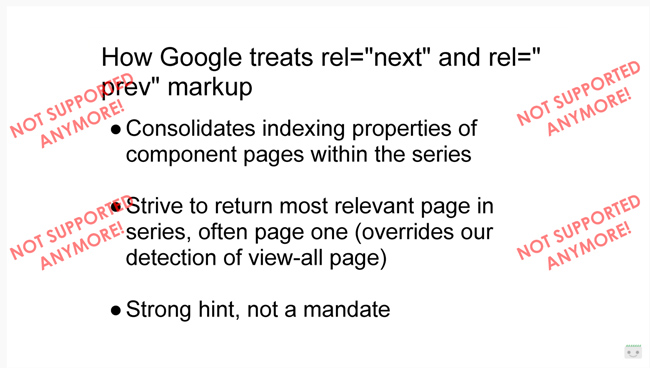
Google Nukes rel next/prev (and nobody noticed):
As I mentioned earlier, in 2019 Google dropped a bomb on SEOs and explained that it doesn’t support using rel next/prev anymore to consolidate indexing properties from across a paginated set. And to add insult to injury, they also explained this had been the case for years! It’s worth noting that it’s still good to use rel next/prev for accessibility purposes, but it will have no effect SEO-wise.
As you can guess, SEOs went ballistic (although I think it’s fair to say we’re happy that they told us!) Google realized this out after checking some of its systems and noticed rel next/prev wasn’t being used for indexing and ranking purposes. Whoops.
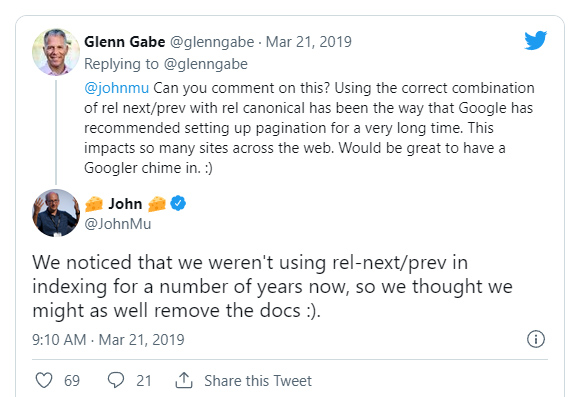
As someone that has helped many companies set up rel next/prev when using pagination, that last point got me thinking… If rel next/prev hadn’t been used for years by Google, and the companies I’ve been helping didn’t even notice that Google stopped supporting it (rankings were unaffected), then maybe Google was pretty darn good at handling pagination.
In other words, maybe we were getting all bent out of shape for no reason. Again, the clients I helped that had a lot of pagination didn’t see any major movement or drops based on Google removing support for rel next/prev. And that also matches what Google’s John Mueller has been explaining for a while. Heck, he even explained that in the tweet thread from 2019. For example, he said “most seem to be doing pagination in reasonable ways that work…” I’ll cover more about John’s recommendations next.
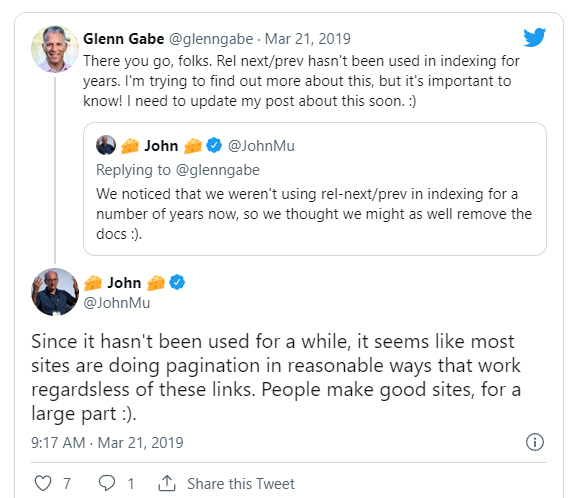
Google’s John Mueller Peppered With Questions About Pagination:
Ever since Google stopped using rel next/prev to consolidate indexing properties, Google’s John Mueller has been asked many questions about the best way to set up pagination. And John has provided some great advice in his Search Central Hangout videos.
John explained that Google has a lot of experience dealing with pagination (as long as it can identify pagination easily). And since it has a lot of experience dealing with pagination, it really shouldn’t have a big impact on a site SEO-wise. It can just “work”.
Also, John often explains the differences between splitting article content into multiple pages and having category pages that contain pagination (listing pages that lead to other urls). Those are two very different scenarios and can be handled differently from a pagination standpoint, if needed.
He has also explained that for category pagination (like an e-commerce category page), you can have all of the pages indexable (which is preferable), you can use “noindex, follow”, or you can even canonicalize to page one in the pagination. It really depends on how well your content is crosslinked, how important the pagination is for discovery, for passing of signals, etc. You can read my post about pagination to see the latest updates from Google about this.
Here is one of John’s latest videos about setting up pagination covering most of what I just explained (at 13:16 in the video):
It’s also worth noting that Google just published some outstanding best practices for e-commerce SEO (where they cover how to handle pagination as well). In that document, they explain to provide self-referencing canonical tags for each page in the pagination (and avoid canonicalizing to page one in the series). That means all pagination should be indexable.
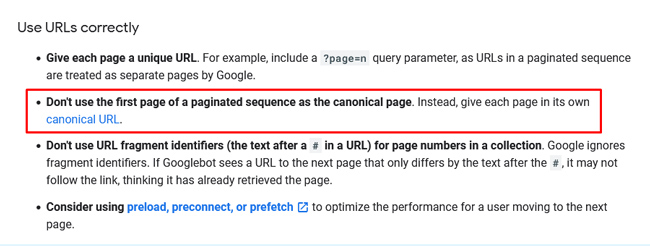
Warning: Nuance Ahead! -Two important points for SEOs and site owners about handling pagination:
As with most things in SEO, there is nuance involved with handling pagination. First, the size of your site is important since you don’t want too much pagination to hamper crawl budget. As John explained, if you don’t have hundreds of thousands of pages (or more), then you shouldn’t really have to worry about pagination impacting crawl budget. But if you do have that many pages, then it’s important to make sure Google is focusing crawling on your most important pages. And that might lead to handling pagination differently across a site. More on crawl budget soon in the case study below.
The other thing I wanted to point out is that I’m a firm believer you shouldn’t have excessive pagination per sequence. For example, I would avoid providing thousands of pages of pagination per paginated set (like one category with thousands of pages of pagination). I think it’s fine to have many paginated sets (if needed), but I would only provide a reasonable number of pages per set (which would be based on your site, content, etc.) That number can vary per site, but I wouldn’t overload your pagination with thousands of pages per sequence. I would do what’s best for users and search engines.
For example, here’s a site with close to 3,700 pages of pagination in one category…

The Case Study: Background information, pagination setup, and indexing levels.
The site I’m covering in this case study has a crawl footprint of about 200K pages (between indexed and excluded urls). I can’t go into too much detail about what the client focuses on, but you can think of them as a site that provides a wealth of information about categories, organizations, products, and reviews of those products. There is also a blog on the site containing in-depth content focused on their niche.
From a pagination standpoint, there is quite a bit of it across the site. That’s primarily on the category, organization, and review pages. Since there are many products and reviews that aren’t crosslinked well on the site (based on how the business operates), the pagination is important for discovery (for Googlebot and for users). For that reason, we definitely wanted to make sure the pagination was indexable and that Google could follow the links on the paginated urls to the product pages, the review pages, etc.
I’ve been helping this company for a long time and helped them craft their pagination strategy as far back as 2012. They have been using the approach that Maile Ohye described in the video I covered earlier. That’s where each page in the pagination contains self-referencing canonical tags, contained rel next/prev (now deprecated), and provided a strong text navigation to the paginated series at the bottom of each page. Remember, this was the recommended setup for a long time. The site has had this set up for years… and you can learn more about that setup in my post about setting up pagination.
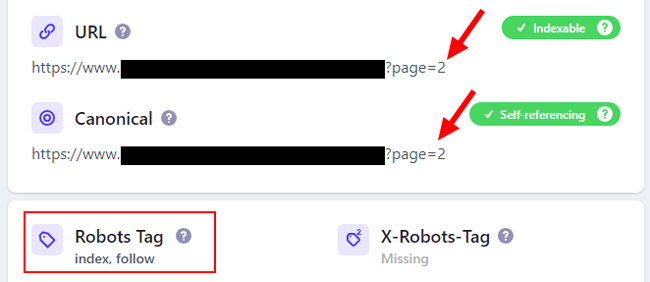
Indexing Levels: Holy pagination Batman!
Based on how much pagination is on the site, it is currently a large percentage of indexed urls. To be specific, the pagination makes up 67% of total indexed pages. Yes, more than two-thirds of indexed urls are pagination! The horror!! :)
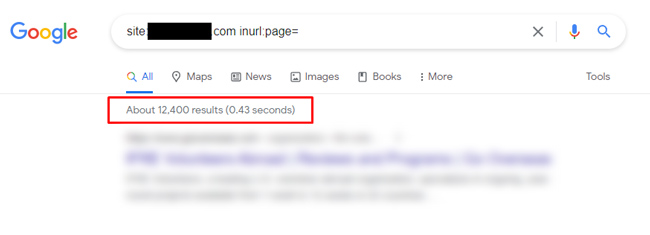
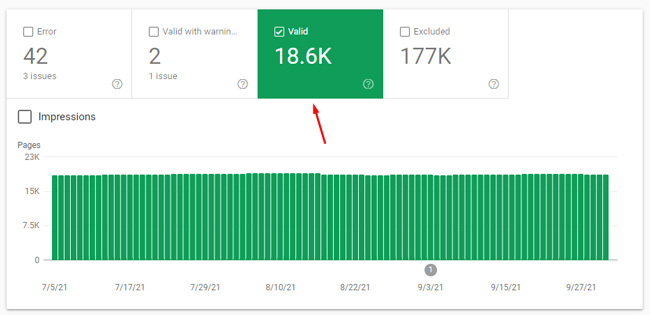
These are not necessarily pages that we want to rank in the SERPs (other than the first page in the set), but we definitely want Google to discover all of the destination pages from the pagination. And remember, rel next/prev was supposed to take care of that for us by consolidating indexing properties from across the paginated set and (usually) surfacing the first page from the set in the SERPs. That’s not supported anymore as I covered earlier. More on rankings soon.
Crawl Budget and Crawl Stats
With that many paginated pages on the site being indexed, what do crawl stats look like? Is Googlebot churning through many paginated pages and missing important, fresher pages?
First, crawl budget is really only something that larger-scale sites need to worry about. For example, Google states that sites with 1M+ unique urls or medium-sized sites with 10K unique urls with “rapidly changing content” need to worry about crawl budget. This site has 18.6K urls indexed and a total crawl footprint of under 200K urls. So, it’s not a small site, but not huge either.
In addition, it’s important to understand that all pages are not crawled with the same frequency (based on importance). Google’s John Mueller has explained this point many times over the years. So, although there might be a lot of pagination on the site, that doesn’t mean Google will continually crawl all of that pagination instead of your fresher (or more important) content.
Here is John explaining this (at 12:42 in the video):
The site’s new content does get crawled relatively quickly. In addition, checking the crawl stats reporting, you can see that fresher content being crawled recently and pagination does not overwhelm the reporting. So despite the site having 67% of its indexed pages being pagination, it’s fine from a crawl budget and crawl stats perspective (in my opinion). That makes sense based on what Google has explained over the years about crawl budget.
Performance over time. How does trending look?
OK, this is where the rubber hits the road. Is having that much pagination indexed impacting rankings or organic search performance at all?
In a word, nope.
The site’s performance has been extremely stable over years (and through a number of broad core updates). They have seen strong growth over the long-term as well (especially from 2012 when I first started helping them).
Here is the past 16 months of trending from GSC:
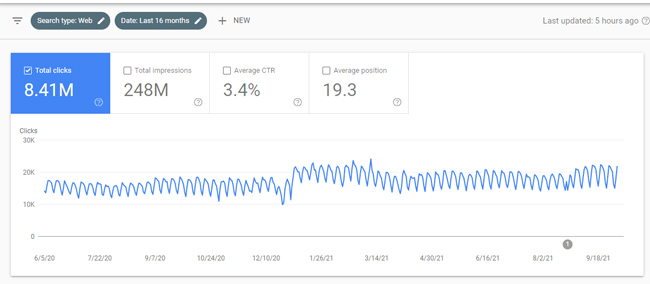
Here is search visibility trending over the past two years:

And here is search visibility trending since 2012:

How about pagination ranking in the search results (beyond page one)? Are paginated pages being surfaced in the SERPs and driving traffic?
No, not really. It accounts for a very small percentage of traffic from Google Search. For example, over the past three months, there have been 1.62M clicks from Google web search. Pagination accounted for just five thousand of those clicks.
Pagination accounts for just .3% of total clicks from Google Search over the past 3 months:
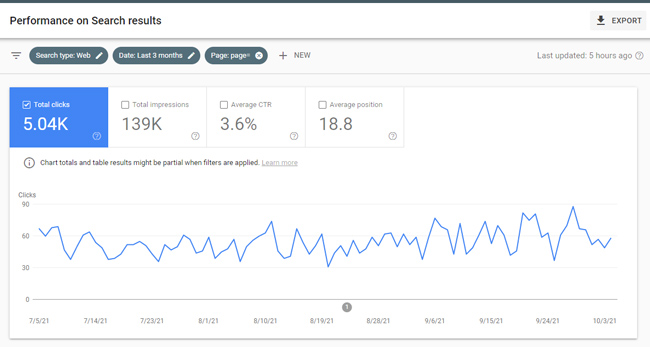
I think the most important thing to remember for this site is that the various “product” pages aren’t being linked to sufficiently from other areas of the site (based on the company’s business model and how the site needs to be set up). So, the pagination is important for making sure Googlebot can get to many of those destination urls. And that’s why it’s important to make sure the pagination is indexable, that it uses self-referencing canonicals, etc.
Final tips and recommendations for sites with a lot of pagination:
So there you have it. A site with 67% of its indexed urls being pagination and it’s chugging along just fine in the SERPs. I’m not saying this approach is what every site should use, but just like Google’s John Mueller has explained many times, Google has a lot of experience handling pagination. It often just works… To end this post, I’ve provided some final tips and recommendations for sites dealing with a lot of pagination.
- Pagination setup: Setup-wise, you have several methods at your disposal for handling pagination. The path you choose depends on the type of content you are dealing with and your internal linking structure. See my recommendations above about content split across multiple pages versus listing pages (like categories), and how well those destination pages are linked across the site.
- Indexable vs. Non-indexable: It’s important to understand that if you noindex pagination, then links on those pages can be dropped by Google over time. So if you want to make sure Google is finding those destination urls via the pagination (and passing signals), I would have the pagination indexable. As this case study showed, it can work very well.
- Canonicalizing Pagination: If you are canonicalizing all pagination to the first page in the series, it’s important to understand that rel canonical is just a hint for Google. It can still choose to index certain pages if it believes that’s the right thing to do. I have covered this in several blog posts over the years. Don’t assume canonicalized pages are actually being canonicalized. This is one reason I’m not a huge fan of canonicalizing pagination to the root page in the set.
- Crawl Stats and Log Files: Don’t just check indexing levels. I would check the crawl stats reporting in GSC as well (and log files if you can get them). As I covered earlier in this post, not all pages are crawled with the same frequency. Google can crawl certain urls on your site more frequently based on crawl demand. That means pagination might not be crawled as much as your homepage, important category pages, product pages, etc. Don’t assume that high indexing levels for pagination means there’s a problem. It could be totally fine.
- Tracking Performance: Make sure you track all of this over time and determine if pagination is causing issues SEO-wise (which I doubt for most cases). Again, Google can handle pagination very well and has a lot of experience doing that (as long as it can identify the pagination easily). Using pagination when it’s necessary is fine (and can be good). I would worry more about the number of paginated pages per set than the total number of paginated pages that are indexed on the site. Like I said earlier, make sure your pagination makes sense for both users and for search engines.
- Google’s Recommendations: Finally, listen to Google’s John Mueller and read Google’s documentation. Google has a lot of experience handling pagination across sites, and it can often just “work”. I recommend implementing a pagination solution based on your own situation, analyze that setup over time, and make sure it’s working for you.
Summary – Yes, your site can be fine SEO-wise with a lot of pagination indexed.
If you are dealing with a lot of pagination across your site, I hope this case study was helpful. I know there’s been a lot of confusion over the years about pagination and SEO, and especially since Google nuked rel next/prev in 2019. As I explained in this post, Google has a long history of handling pagination and it typically will not cause many problems across a site rankings-wise (as long as it’s set up properly). The approach you take really comes down to your own site, the type of content, and the internal linking structure. And if you end up having a lot of pagination indexed, then so be it. As this case study proved, it can work out just fine for you.
GG


